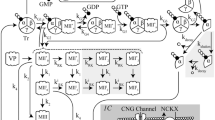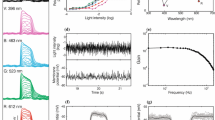Abstract
A mathematical model predicting many facets of the PDA phenomenon is presented. The phototransduction process is divided into three interacting sublevels: pigment kinetics, transmitter dynamics and coupling of the signal to the membrane potential. The dynamics of each is studied, while showing their characteristics and limitations. Control mechanisms are proposed to overcome these limitations and to achieve good sensitivity in their dynamic range. For example, it is claimed that enzymatic gain modulation underlies the post-stimulus behaviour of the invertebrate photoreceptor cells. This hypothesis is further explored through a quantitative and qualitative analysis of the model. The results agree with the general PDA characteristics inferred from the large amount of data available from the literature in the last decade. This work provides a theoretical framework which unifies the phototransduction data into an overall system organization.
Similar content being viewed by others
References
Baylor DA, Hodgkin AL, Lamb TD (1974) Reconstruction of electrical responses of turtle cones to flashes and steps of light. J Physiol 242:759–791
Blumenfeld A, Erusalimsky J, Heichal O, Selinger Z, Minke B (1985) Light-activated guanosinetriphosphatase in Musca eye membranes resembles the prolonged depolarizing afterpotential in photoreceptor cells. Proc Natl Acad Sci USA 82:7116–7120
Carpenter GA, Grossberg S (1981) Adaptation and transmitter gating in vertebrate photoreceptors. J Theor Neurobiol 1:1–42
Carpenter GA, Grossberg S (1983) Dynamic models of neural systems: propagated signals, photoreceptor transduction and circadian rhytms. In: Grissell R, Hodgson JPE, Yanowich M (ed) Oscillations in mathematical biology. Springer, Berlin Heidelberg New York (Lecture notes in biomathematics, Vol 51, pp 1–93)
Franceschini N, Kirschfeld K, Minke B (1981), Fluorescence of photoreceptor cells observed in vivo. Science 213:1264–1267
Grossberg S (1982) Studies of mind and brain. Reidel, Dordrecht Boston London
Hamdorf K, Razmjoo S (1977) The prolonged depolarizing afterpotential and its contribution to the understanding of photoreceptor function. Biophys Struct Mech 3:163–170
Hamdorf K, Razmjoo S (1979) Photoconvertible pigment states and excitation in Calliphora; the induction and properties of the prolonged depolarizing afterpotential. Biophys Struct Mech 5:137–161
Hillman P, Hochstein S, Minke B (1983) Transduction in invertebrate photoreceptors: role of pigment bistability. Physiol Rev 63-2:668–772
Hochstein S, Minke B, Hillman P (1973) Antagonistic components of the late receptor potential in the barnacle photoreceptor arising from different stages of the pigment process. J Gen Physiol 62:105–128
Horridge GA, Tsukahara Y (1978) The distribution of bumps in the tail of the locust photoreceptor afterpotential. J Exp Biol 73:1–14
Lamb TD (1981) Biophysics of, transduction in vertebrate receptors. In: Reichardt WE, Poggio T (ed) Theoretical approaches in neurobiology. The MIT Press, Cambridge, MA. London, pp 7–17
Lisman JE, Sheline Y (1976) Analysis of rhodopsin cycle in Limulus ventral photoreceptors using early receptor potential. J Gen Physiol 68:487–501
Minke B, Hochtein S, Hillman P (1973) Early receptor potential evidence for the existence of two thermally stable states in the barnacle visual pigment J Gen Physiol 62:87–104
Paulsen R, Bentrop J (1984) Reversible phosphorylation of opsin induced by irradiation of blowfly retinae. J Comp Physiol A 155:39–45
Razmjoo S, Hamdorf K (1976) Visual sensitivity and variation of total photopigment content in blowfly photoreceptor membrane. J Comp Physiol 105:279–286
Razmjoo S, Hamdorf K (1983) The possible role of rhodopsin and the microvillus in light adaptation of the photoreceptors of an insect. In: Cosens DJ, Vince-Prue D (ed) Biology of photoreception. Cambridge University Press, Cambridge, pp 109–131
Stavenga DG (1976) Fly visual pigments. Difference in visual pigments of blowfly and dronefly peripherial retinula cells. J Comp Physiol 111:137–152
Stavenga DG, Schwemer J (1984) Visual pigments of invertebrates. In: Ali MA (ed) Photoreception and vision in invertebrates. Plenum Press, New York London, pp 11–66
Stryer L (1983) Transducin and the cyclic GMP phosphodiestrase: amplifier proteins in vision. Cold Spring Harbor Symp Quant Biol 48:841–852
Wright R, Cosens D (1977) Blue adaptation and orange adaptation in white eyed drosophilia: evidence that the prolonged afterpotential is correlated with the amount of M 580 in R 1–6. J Comp Physiol 113:105–128
Author information
Authors and Affiliations
Additional information
Supported by NSERC grant A-9731
Rights and permissions
About this article
Cite this article
Öğmen, H., Gagné, S. Phototransduction in invertebrates. Biol. Cybernetics 56, 27–35 (1987). https://doi.org/10.1007/BF00333065
Received:
Issue Date:
DOI: https://doi.org/10.1007/BF00333065




